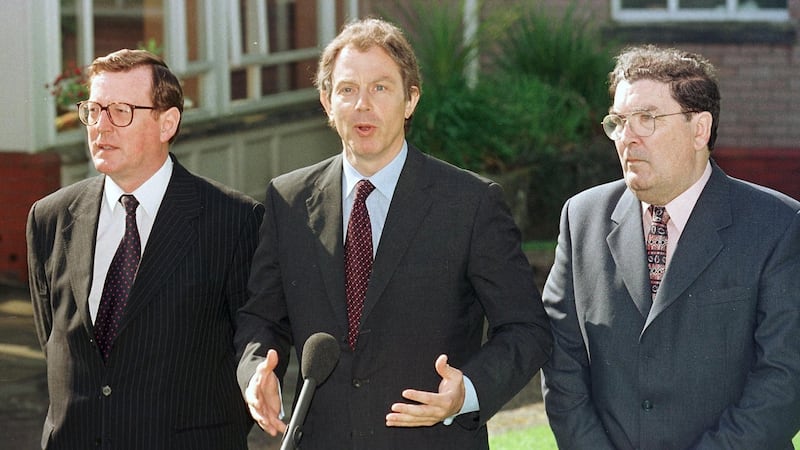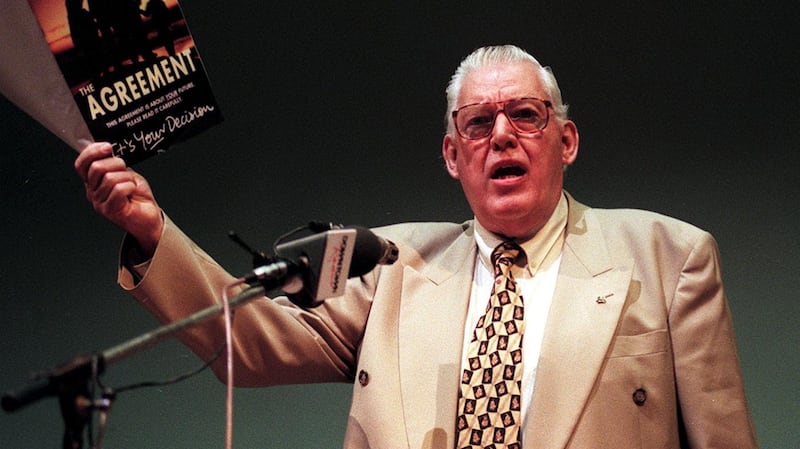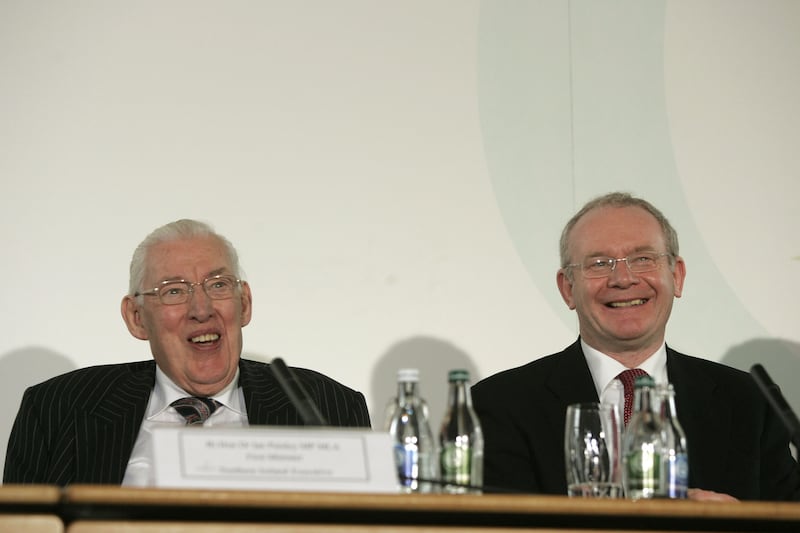“I have it in my hand,” so said Stephen Grimason on BBC TV on Good Friday 1998. In his hand was the text of the Belfast Agreement.
It was “the biggest story in the western world that day” and he had scooped the other broadcasters in getting the document to air first. This was about 1.30pm on the day. There were still a few hours to go before the press conference where the document was officially released.
So, who gave him the scoop? He’s not telling. He references Isabel Oakeshott and her shafting of Matt Hancock and notes drily, “A source is not just for Christmas”.
He will take the name or names to the grave, which is more apt than you would want it to be.
RM Block
A native of Lurgan in Co Armagh and from a Protestant background, Grimason is an old school journalist. He loves the trade, came up through provincial newspapers and made it as political editor of the BBC in Belfast, eventually transferring to the dark side as the boss of communications at Stormont. In the run up to the anniversary of the referendums that secured the deal, he knows the story of Good Friday and its aftermath from the outside and inside.
If he won’t name his source, will he say why he got the scoop? “I’ve thought long and hard about that,” he says, recalling how on the day there was a lot of nervousness about, especially in the Ulster Unionist Party – and especially around issues such as early paramilitary prisoner releases, policing and decommissioning.
“I believe I was given the document to nudge it over the line.”

That makes sense. There were a number of unionist waverers around that day. While there was an agreement paper, the deal was not absolutely done. Not so long after he told the world he had it in his hand, the current DUP leader and then a senior Ulster Unionist, Jeffrey Donaldson, walked out of Stormont, unable to stomach the deal.
Another potential exiter was the UUP Strangford MP John Taylor, a big noise in the party at the time. Earlier that week, he said he wouldn’t touch the draft document “with a forty foot pole”. If Taylor had followed Donaldson, it is possible the whole painfully and carefully constructed historic compromise of the powersharing deal would have collapsed.
Grimason, however, reckons that as soon as Donaldson quit the talks, Taylor gave the UUP leader, David Trimble, the green light to run with the agreement. He recalls a great line from another Ulster Unionist that helps define the enigmatic, unpredictable John Taylor, now Lord Kilclooney: “Oh, he’s an awful man. He’s like the corncrake. You can always hear him but you never know what field he’s in.”
Grimason has just turned 66. He has terminal cancer which has been managed for a couple of years now and, he hopes, will be managed for more years to come.
He has a £50 bet with another journalist about which of them will die first. Thankfully, while suffering his own hospital adventures, this other journalist is in good shape. It sounds macabre but it’s not; in its paradoxical hard-nosed journalistic way, it is funny and life-affirming.
“We survived the Troubles on the basis not of counselling, which we never had, but on black humour and alcohol.”
He is not afraid of dying. “In the past couple of years there have been about five occasions when everybody thought I was going to croak. On each occasion, they brought me back from cardiac arrest, from zero blood pressure and from some very dangerous surgery.
“The interesting thing about that is dying is pretty easy. And if you think about it, it must be easy because millions of people do it every day. There are no lights, there are no bells, there are no whistles, you just fall asleep. And, as someone who is not a person of faith, that is a great comfort to me.”

Talking about easier topics, he proffers his thoughts and memories, from his perspective as a journalist and as Stormont director of communications, about the main players from 1998. After David Trimble died in July last year, Grimason posted a tweet about the “pygmies” who had tried to bring him down. He has great respect for the former First Minister and how he persuaded a hesitant and frequently reluctant Ulster Unionist Party to endorse the agreement.
“You don’t really understand just how strong Trimble was until you saw him in trouble,” he says, arguing that one of his “most underrated strokes” was in the lead-up to Good Friday, 1998, in managing to enlist the support of the Progressive Unionist Party and the Ulster Democratic Party, political bedfellows of the Ulster Volunteer Force and the Ulster Defence Association.
This was crucial, Grimason adds, because during the last serious attempt at powersharing – the Sunningdale Executive of 1974 – it was the “paramilitary muscle” of the UVF and UDA working alongside the likes of Ian Paisley and (in another paradox) Trimble himself that helped wreck that experiment.
On the night of Holy Thursday 25 years ago, Paisley led a large crowd to Stormont with the intention of doing some more wrecking. Police had warned journalists to be careful as there were some very angry people involved. They did not get through to the talks site at Castle Buildings well inside the Stormont estate but Paisley and some of his senior people were allowed in to deliver a press conference opposing any deal and warning of a “sell-out”.
Times had changed. He was roundly barracked by the loyalists who had made their way into the Portakabin where the DUP leader was speaking – 1998 was a long way from 1974, was the message.
“How Trimble got all those people into his camp is absolutely fascinating. There would not have been a Good Friday Agreement had he not done that.”
Grimason has high regard for some of the loyalist leaders of that time, especially David Ervine of the PUP. Part of the deal was that paramilitary prisoners would get out after serving a maximum of two years, regardless of the offences.
In the closing stages of the talks, Sinn Féin’s Gerry Kelly went to Ervine seeking support to prompt a reduction of the early release scheme to eighteen months or a year. “And David Ervine said, ‘If you get this down to eighteen months or a year the unionist people will not vote for it. So, the answer is no.’
“That showed great wisdom. For all the grief and abuse that loyalists got, they played their part.”
Grimason says that Trimble, when he finally quit Northern Ireland frontline politics for a calmer life in the House of Lords, told him that the DUP and Sinn Féin eventually would become the “big ticket”.
“He said, ‘Wait till you see how they are going to try to reinvent and rewrite history and look like the good guys.’ I would see him every few years and he would say, ‘How is it going?’ And I would say, ‘You were right.’
“And you have to keep people honest because this was a deal done between the SDLP and the Ulster Unionists. Sinn Féin were not minor players but not major players.”
He has fond memories of the late Seamus Mallon, although trying to manage two “irascible” politicians – him and Trimble – could be a trial at times. “Seamus could wind David up like nobody else I knew.
“But, I couldn’t not like Seamus. And for all his talk about being an Irish nationalist, he counted as one of his finest days playing for the House of Commons golf team against the Lords.”
Most everybody knows that the relationships between Mallon and John Hume was edgy. Grimason remembers one late night after an SDLP annual conference when Mallon was holding court in the bar with a group of journalists including him and UTV’s then political editor Ken Reid.
After a while Hume came over and joined the company but in the next 30 minutes of general chat, Hume did not say a word to Mallon and Mallon did not say a word to his leader. “So, Ken Reid stood up and said to John, ‘John, have you met Seamus Mallon?’” Collapse of company.
“But, it is my view that John was the greatest Irishman who ever lived – living or dead. I make no apology for that because he tried to finish the unfinished business in a way that was sustainable. He had the answers from the start, from the early ‘60s. You know, my children have grown up in a largely peaceful place. He was a remarkable man but my God was he hard work.”

Grimason sees Ian Paisley as a man who finally came good after decades of causing mayhem and mischief. When Paisley and Martin McGuinness took over as First Minister and Deputy First Minister in 2007, “there was a real closeness” between them. “I think, in Paisley’s terms, he saw Martin as the Prodigal Son, who learned the errors of his ways and he was going to slaughter the fatted calf for him. Their relationship was a visible sign that [the conflict] was over.”
Stormont is a vast estate that features many buildings, including Parliament Buildings and Stormont Castle, where, at the time, the Northern Secretary Peter Hain and his officials had their offices.
“It was proposed that they would write to Hain asking him to vacate the castle so they could have their offices there instead of at Parliament Buildings. I thought the Shinners will never do that because they’ll be called ‘Castle Catholics’ but they were happy to do it. It resulted in Martin saying to the Doc, “You know that your first letter as First Minister is a Brits Out letter.”
Grimason could never quite figure Gerry Adams. “You can always say that you knew Martin but I don’t think, even to this day, you could ever entirely say you knew Gerry because he’s kind of like the layers of an onion. You pull back one layer and you get another layer. And he’s always been very careful to keep himself from – you know – not least the stuff about was he in the ‘Ra.”
Looking back on it all, Grimason says it was a good life from outside and inside the Stormont tent. He carries a difficult weight lightly. Hard-boiled journalist to the last, he quotes Kris Kristofferson: “The going up was worth the coming down.”
Recently, he did an interview with William Crawley on BBC Radio Ulster’s Talkback programme where he also picked his favourite music. Top of the list was Paul Brady’s the Island, written in 1985, with its many redolent lines including, “Up here we sacrifice our children to feed the worn-out dreams of yesterday and teach them dying will lead us into glory ...”
“I just think it is the anthem of the Troubles. It is the most perfect song. It starts in the Lebanon at a time when it was going berserk and it takes us back here.” And he concludes with quiet emphasis, “It is a timely reminder of where we have been and why we don’t want to go back.”


















